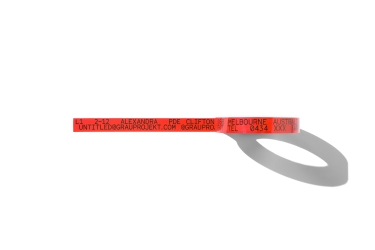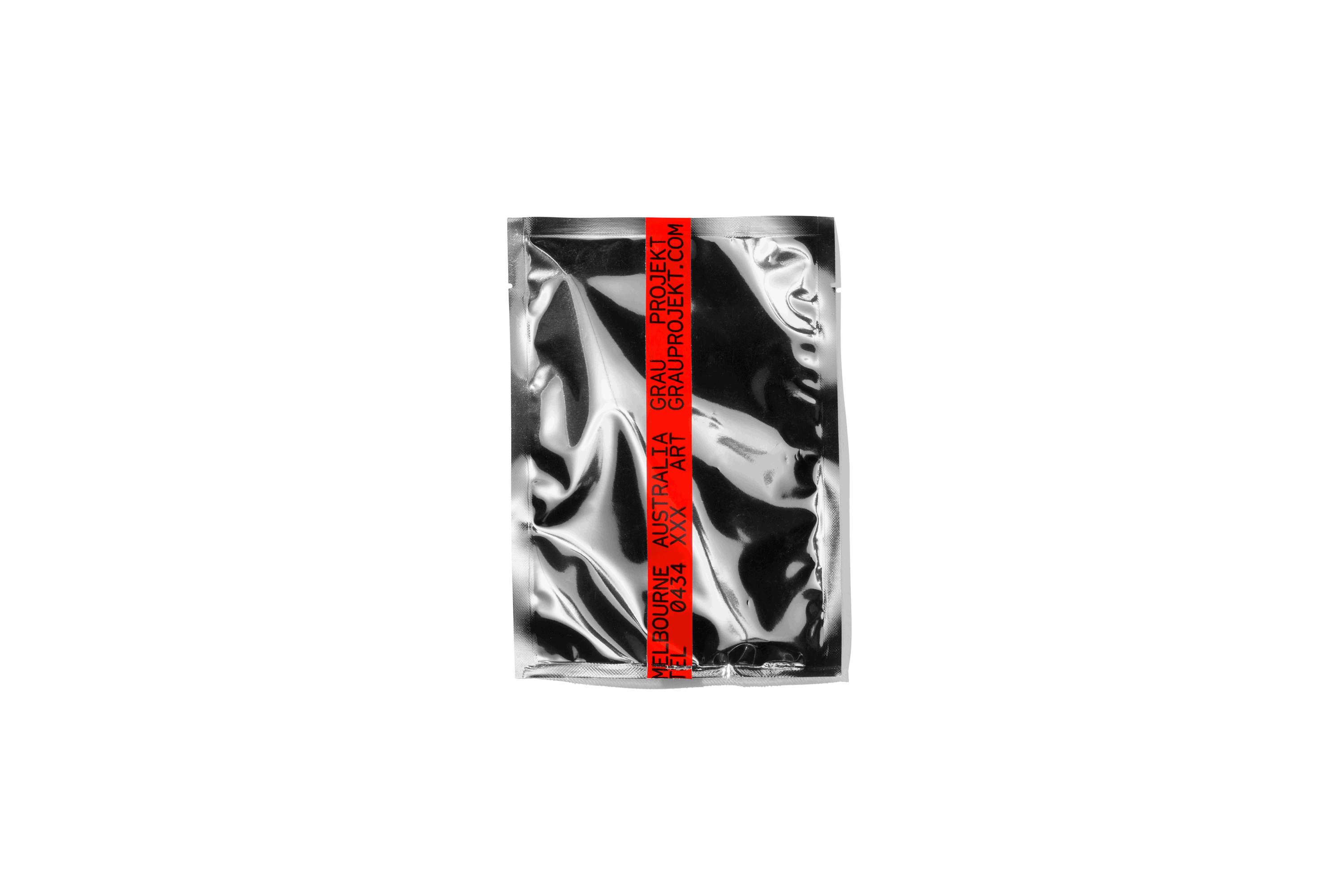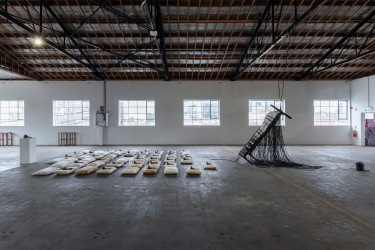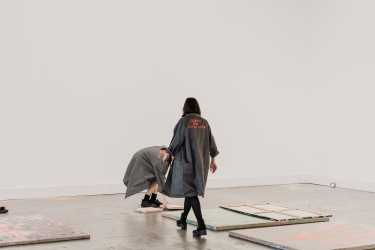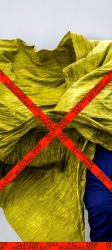Brand identity and merchandise for Grau Projekt, a gallery and bar with rotating artist exhibitions.
A conversation between Matthew Bax (MB) from Grau Projekt, Rhys Gorgol (RG) and Luke Brown (LB) from The Company You Keep and Matt Leach (ML) from Australian Design Radio.
Matt, firstly I’m really interested in what motivated you to establish Grau Projekt?
It came about from seeing a bit of an opportunity in the art market or in that commercial space that was, if not overlooked, then forgotten in a way. It seemed to me that from an artist point of view and from a collecting point of view, the experience was pretty bland and it was in some ways taken for granted — in that there was a rolling exhibition schedule of 3 weeks to a month and it felt at times a bit soulless from the point of view of celebrating the art and the contribution of the artist and what had gone into that, and also from an experience point of view. Going to see the show, if you’re buying work or not buying work, seemed a bit tired and a bit dead. In Australia with the arts, it can be a bit pessimistic from both ends of the spectrum at times and the question’s always, “Well, what are you doing about it?” It’s easy to complain. That was what prompted us — how can we reimagine this and how could it be different? Some of the confidence had come from the hospitality side of things, knowing that we could put on a good event and knowing that we could deliver something different. It was our response to what was perhaps a broken business model.
Is that where the name came from?
Sounds wanky, but I was at Documenta at the time, and I was thinking about those sorts of art experiences compared to the standard feelings of going and seeing a commercial show in Australia — how could you pump a bit of life into the art experience? That’s where I landed; it’s not a commercial gallery per se, it’s not a standalone art space, it’s not a hospitality venue but maybe a blurring the lines of that grey area.
Talk to us more about the hospitality side of things. Maybe that’s the thing that doesn’t come through as easily to understand in the imagery.
We have this concept called “artist curated drinking”. A couple of years ago it sounded quite unique but now everything is just fucking curated so now it’s pretty bland. It was the idea of giving people an excuse to come out and see a show — it’s targeting that museum crowd that might go to the NGV on a Friday night, but they may not go and see a commercial show every month. So in a way, tricking them into coming out and looking at art they may not normally look at. The other side of things is giving the art world and the art crowd something a bit more exciting than the standard crappy wine. The cheapest white and red you can get your hands on and a hundred art students guzzling it down. To make it a little more special. I’m also fascinated with that idea of communication between different disciplines, and food and drink and art; it’s one that’s really hard to bridge and not done very successfully. We’ve still got a long way to go. So, each show we work with the artists and come up with an event which has a close relationship between what you’re drinking and the art and the show, and trying to enhance the entire experience. A collaborative experience as opposed to just getting some cheap wine into people.
It sounds almost like an art degustation –
It’s just opening up that question of what art can be, building a better connection with the audience, and we’ve got a few tricks to do that.
Rhys, the idea seems very different to what other galleries here are offering. So, I’m interested, does that make it easier or harder for you?
When Matt Bax comes knocking on our door it’s never easy, but it’s never hard. (laughs) When you meet your match in a client, it’s fun. The idea of playing tennis with someone intellectually and conceptually allows for some really interesting results, and Grau is the first time Matt and TCYK have worked together in the art space. Matt has a very extensive art practice and it’s always been a part of his career, but he’s also got a very extensive hospitality practice. In the past we’ve worked in the hospitality space with Matt. When it came to the gallery, regardless of what Matt does, he’s always doing it differently to everyone else. To answer your question, it makes it easier in that it’s different to the conventional model. You’re not trying to fabricate or create a facade of difference or distinctiveness. There’s inherent differentiation from the concept up. Which means that we can be more pure in the design representation of that because all we need to do is define it at its core and then present it in a pure fashion and all of a sudden it’s going to be unique in the market, as well as a true representation of the voice or the space that the brand is trying to create.
Matt, I’m interested — with your art background, did you have initial ideas around the brand or something that you were looking for it to embody?
I had some ideas of what I didn’t want it to be. I always found it weird in the art space that it’s arguably the most creative commercial field out there and yet you could throw a blanket and cover 99 percent of galleries. It’s minimalist, it’s white, it’s black, it might be grey, it’s essentially all the same. I knew I didn’t want it to be that, but we talked a bit about fashion branding, and we talked about it being perhaps more in that museum space. I didn’t really have anything fixed in my head, but I just knew that I didn’t want it to be like everyone else, because I knew we were coming up against some big challenges. Being brand new to the market, it’s a pretty tough industry to survive in, let alone make any money. I knew we had to come up with something pretty special to spark that curiosity. I knew the branding was going to be important.
Luke, when someone approaches you with a distinct style, as Matt has — how do you design for that? Is it a case of trying to capture the essence of it? Or are you looking to strengthen what’s already there?
It’s a bit of both. “Capture the essence” is exactly right. As Matt mentioned, we were interested in exploring other spaces that have a visual representation of a brand, like fashion, that are in your face and overt and a real challenge to the normified, minimal, white, black type that you see in any other gallery space. I understand why a lot of those spaces do that — they’re trying to be as quiet as possible, and we thought there was a real opportunity to be really loud and aggressive, in a way. Because this space, this gallery, this idea is doing something different and it is challenging the mould, and so it should really embody that idea. In some of the references, we asked, “Well, who are other trailblazers of their spaces?” Whether it’s Comme des Garçons or Virgil Abloh — these kinds of people that are disruptive. We thought, “What are they doing?” They’re being uncompromising, they’re confident, they’re loud, and they’re in your face. So we thought, there’s some brand language we can build on from that — such as this red that is really vibrant; it’s the opposite of white and black. It’s loud, it’s out there. But what was really interesting — and it’s something that we love, when Matt comes to us, when any client comes to us and there is a sense of collaboration — Matt had drawn on a napkin and he said, “Oh, I’ve got to write the dates, there are 5 shows and maybe we can put them in these quadrants”. He drew this grid, and he wrote the dates in the quadrants. We thought, brilliant, there’s your logo. Basically all we did is we took this sketch that he had and thought, “Well, this is the grid system. He’s made the grid system for us, let’s bring this to life”.
A huge piece of the work here was trying to embody the attitude Matt was taking to not only his practice to date within hospitality and art, but also in this venture. Which is counter-culture as well as very “Let’s get it done”. Uncompromising. There is this optimism to it, but there’s also this doggishness — “No one else is going to do it, I’m going to get it done”. And within the art space, you could see as we’ve talked of to date, the tropes of the white square or the white cube gallery model. If you’ve got a business or an attitude that is counter to that, actually take a stance or have a position as a presentation space, rather than trying to recede and then run away; that’s something that is really interesting. Because Grau not only presents works, it engages with the work or has dialogue with the work. Rather than just being a space for hire; it’s really that personality, that attitude that we’ve tried to embody through any of the graphic design mark making. Whether that is typography, colour, composition or any of those base elements that make up brand or design.
How important is it to have a system, knowing that the design needs to sit alongside incredibly diverse artworks?
In terms of the brand system, when it sits alongside a variety of different works, it is that balance between having dialogue with the work but also allowing the respectful presentation of that work. No matter the diversity of the content that was plugged into it, it’s a matter of ensuring that the attitude of the space and the brand is present. In equal part the content is presented in a true or pure fashion where its meaning or its intent isn’t obscured or abstracted from the original artist’s intent. Beyond the aesthetic or the narrative component of that, pragmatically it just allows for an operational efficiency. This is incredibly important for an organisation like this. You don’t have unlimited resources, and then those resources are broader than just financial; they’re time based resources. So every time you’re putting on a show or anytime an opportunity comes up, regardless of whether that’s a new show or whether that’s a new format, like presenting an artwork in a book, or a piece of merchandise, or a website — allow the organisation to preempt and know how the brand behaves, so it can make the most of that opportunity.
One of the things that a system provides is a real sense of recall and recognition. You can see these posters on the street and they’re really vibrant. But what you really see from a distance is the system, is the grid. You know from a distance straight away, “Oh, that’s Grau Projekt”, without even knowing which artist is on. That’s the first recognition. The second step is, “Great, what’s the show? I’m going to go”.
Matt, I’m interested — having the grid system, is that something that makes it easier to explain to the artists how their work will be represented in advertising and brochure and collateral?
It’s for continuity of the brand. Which is up to the artist as well, but that’s got to be clear. If you’re chopping and changing for every show and every artist has a different idea as to how they see their work and how they present it, then you’re putting a very mixed message out there. Especially if we use our posters, for example, or magazine advertising, it’s all text based. In a way it’s very respectful in that there’s never a question in terms of hierarchy and where the work’s sitting and where the brand’s sitting. That very text driven idea is more about seeing the grid and thinking “Oh, there’s another show on”. That’s probably our first point of call. Then the idea of pushing the artist’s name; being a bit more powerful than a poster that’s got an image you would just walk past. I’m very interested in design that has a strong link to a practical way of approaching it.
It’s a great point, that most people have a great visual recall for a work — “I’ve seen that painting before, I’ve seen that sculpture before”. But they probably don’t always remember or always remember the artist. By hearing about the artist through typography we are promoting them and their name more. Because that’s the thing people can go home and google later, whereas you can’t google a painting.
It’s interesting because it’s a juxtaposition of the traditional gallery model, where the name of the artist isn’t necessarily up in lights. It’s not about theoretically building the profile of the artist, it’s about presenting that body of work, and Grau is almost counter to that. Even though you’re not seeing the visual part of the work, you are seeing the name of the artist immediately. In one way they are playing a huge role in building the profile of that artist and the self-sufficiency of empowering not only the market, or connecting people with art as a whole, but also that artist as a practitioner as well.
If you’re looking for other reference points it’s only museum shows or the biggest artists in Art Forum that could be allowed to just have a purely text based advertisement. It’s something you have to almost wait for permission. Our approach is that the promotion of the artist is first and foremost in our mind. Pushing them and their practice is paramount to what we’re about and almost letting the art sell itself. As opposed to the older model of “wheeling and dealing” which we’ve almost got no interest in at all.
Luke, one of the really distinct parts of the brand is the use of the red tape. Can you tell us more about where that idea came from?
One of the things we were interested in — this links back to Matt’s art practice — we’re obviously looking at a lot of his works, particularly some of his works while working in Berlin, and there is this guerilla approach to his own artwork. So tape as an idea in itself, it’s quite lo-fi. It comes in red and it’s quite guerilla. You can grab this tape and you can do your own marketing, guerilla marketing. You can tape over things in this strip and you can tape that grid system up anywhere and you’ve got your own billboard. Without having to take a big ad spot out under some bridge, you can just do it yourself with tape. We love that idea and that approach. That DIY aspect to the tape.
It really comes back to the model of doing something different within the space. As Matt alluded to, art as a sector is one of the most progressive sectors in terms of creativity and in terms of the work that the practitioners are doing within this space, and what they’re exploring through their discourse. But the gallery model per se wasn’t necessarily keeping up with that. It reminds me of the Dadaists, where they are coming back to the origins or the birth cries of modernism. Where they’re questioning, what is art? Actually pinpoint that down. Sometimes within models, the conversations we are having at the start are that maybe that’s been lost. So could a brand or could Grau re-empower people to think again, or to question again, what is art? Or what is a gallery? Or what is a bar? What is an art experience? Not only within society at large but the role that it plays in their lives. Through this tape tool, it allows you to apply that in a very simplified format in that grid, over the top of anything. And with that intervention you are essentially evoking the question of, “Is this art?” Or asking someone to look at whatever that subject matter is again, which was quite an interesting component that came out of the dialogue of the origins of the brand.
Rhys mentioned Dada and that was definitely a reference point. We talked about other fashion references and Fluxus was another one that we referenced quite heavily and spoke about a lot, because Fluxus emphasises the process over the finished product. With this tape, you’re seeing this layering. It’s never perfect, it’s not a metro light billboard, it’s this process driven poster that’s out there and it can be with any form that you’re using the tape for. That to us really resonated strongly and resonated with Matt, and really informed a lot of our design decisions.
Tell us more about the type as well, because that seems like a very important part of the brand.
We used a typeface called GT Cinetype. It was based on an old subtitling typeface that hadn’t really ever been used, other than in the cinema world and that was completely irrelevant to the choice behind it. If you zoomed in on this typeface, you look at it, it’s made of these rectangular angles — if you were to grab a bit of tape and you were to draw the letter ‘g’ on a wall, you would tear a bit off, you would do another angle, you would do another angle. You don’t have these curvatures. So that’s the detail of where it came from. We liked that you might not even see it in this 9-point type but there is a conceptual link in this typeface choice that links to the idea of the tape.
The other thing that we found through the serendipity of that is whilst it links to the tape, it is also embodying this sense of being uncompromising. Because you aren’t taking the easier route of just drawing a ‘g’ in a conventional way using Bézier curves and angles; you are having to replicate those forms through micro movements. The origins of the type was that it was just the constraint of the technology, as they were burning the type into the film for the subtitles. But that gave it a very specific formal quality and conceptually that was relevant to how the brand was presenting itself as an attitude. Also formally it was relevant to the brand in terms of the tape device, and the very angular nature of that expressing across a lot of the interfaces.
Matt, you spoke about this idea of finding other avenues to get art into people’s hands. So this idea of merchandise, is that something that was part of the plan all along?
Definitely. What we were interested in doing was breaking down some of those boundaries to how we perceive the commercial space. A lot of the time if you’re not familiar with visiting those sorts of places they’re not the most comfortable. Comparing that to a museum experience where it’s a little bit more welcoming. There’s also a way of engaging with an exhibition, whether it’s a bag, or a postcard, or a t-shirt — and I really like that idea of being able to build that connection with the work. Other than buying a catalogue with a show, if you can’t afford the artwork, there’s nothing to format that personal relationship with the show, or the work. So that was the main motivation for some of our merchandise. Firstly to connect with the show, but also a bit of signalling. If you’re carrying a Grau tote, it’s putting it out there that you’re interested in contemporary art.
We talked about the references, and fashion being one of them. You can see a Rick Owens tote bag, you can see a Comme des Garçons tote bag; they’re recognisable and people want the tote bag because they believe in the brand. There’s a cache to that. There are these items that we were excited about developing with Matt which are the extension of that same idea. So someone can come in and think, “Yeah, maybe I can’t afford the artwork. But I am connected with this brand”. This is a gallery and this is a brand, it’s not just a gallery and I want to show my connection to that publicly. So you get these movable billboards. It’s really fantastic when you’re walking through the city, or anywhere — you see these red handles, just bobbing along with someone’s normal daily stuff in them — iPhones and wallets and what have you, and you think “Oh, cool! That person knows about Grau”. That’s exciting, and then you see them bobbing everywhere and it becomes not so much of a trend, but this signalling for, OK, they’re interested in contemporary art, that’s exciting.
It’s almost “tribe building”, isn’t it?
Yes.
In terms of the format, it really allows you to explore the formal qualities of the brand and how they can be reinforced. So again, the tape as a device. This rectangular red totem expresses tape in one way, but it also expresses a handle here. As it continues to adapt and morph and apply across a bunch of different interfaces, so too does the complexity, or the pluralism in which people may perceive the brand and the possibilities of what might be offered in that space.
There was a moment where we used a bit of a cliché in the art world; the red dot. You see the little red dots next to the art, and we used that to indicate which drink you’re having on the cocktail bottle. We’d be lying if we said we weren’t having fun coming up with other merchandise ideas, like a builder’s pencil. Why is that? It was thinking, “How do we break the mould of what’s traditional?” There’s the catalogue, there’s the postcard. Well, what’s true to Grau? OK, there’s a tote bag, there’s a crazy big neon poster, there’s a pencil, there’s a key ring, there’s a glass with a dick on it. There’s all this great merch and some of the art can link back. Matt’s own work is linked into some of the merchandise as well, which is a great extension for that, and again, for people — you don’t want it to be inaccessible. People can come there, and they can think, great, I can take this glass home for $15 and it’ll be my memento for the show.
With a dick on it. (laughs)
You touched on something interesting there, Luke, around having fun with it. This is something which gets lost in a lot of projects, practices, businesses. The attitude of not necessarily being uncompromising and those sorts of things, but there’s also a levity to it, there’s an enjoyment; this isn’t life and death. There is a sense of humour and sense of lightness of spirit in the way that the work and the brand has been created, but then also presented to market. Even though it’s not overtly communicated through the written word or through anything like that, that energy comes across to people that are experiencing it. As Matt mentioned, breaking down barriers for people who may not have felt a resonance or that the art space was open to them, or they were allowed, or they had permission for that space. Grau really wants to be open for those people, and that lightness of spirit, or that fun in terms of the creation process, and that energy coming through really permeates into the demographics that come across the space.
That’s a really good point. We were talking about why perhaps the commercial space was a bit stale, why it was a bit boring. You don’t describe serious commercial galleries as ever being fun. You can take yourself very seriously and the work can be serious but it doesn’t mean it also can’t be fun. And outside of student shows or artist run initiatives, that word, “fun”, you would never use in a conversation about a show, and there’s no reason why that should be neglected. It’s pretty off-putting when you think, “Well, that doesn’t sound like much fun.” Who wants to go see that show? That’s a good point, I’ve never thought about it much.
It’s also limiting in terms of the spectrum of emotion. If art is there to explore and progress, that’s 360, that moves in all different directions. So why does one component of the spectrum become illegitimate to this space? As though it’s not serious or it’s not authoritative unless it’s austere or it’s cold or it’s solid. In the same way that’s why Dada and Fluxus resonate with me. There are these other emotions as part of the human experience that are under-documented or under-represented in this space, and they’re enjoyable. When you’re thinking about people that may not necessarily be engaging with this space in terms of art and you’re trying to entice them into a world to show them things that they might be missing out on, you can’t do that with “This is serious, take it seriously, come here and enjoy it!” You’ve got to meet them on their own terms and make them want to come there.
One of the really arresting visuals that I’ve seen is this use of this silver bag. Can you explain more about what that was and where it came from?
One of the reasons we talked about using the silver comes back to that idea we’ve been talking about where something original doesn’t have to cost the earth, either. You don’t need this paper harvested from Egypt, 1962 to be a true representation of this brand or be a representation of quality, you can do it with off the shelf things. You can go down to Bunnings, you can find some interesting clips, you can find some off the shelf silver zip bags, you can find heat press silver bags and you’ve got a really strong visual language through packaging. It doesn’t look like anything else but it happens to be off the shelf and DIY, and then you just wrap it in some red tape and you’ve got this authentic Grau Projekt brand expression. We love that, that it doesn’t need to cost the earth. It can be off the shelf, and that’s exciting.
And the embracing of these utilitarian elements that are ubiquitous means that there’s a practicality in utilising that across different formats. So whether it’s a vac sealed bag or whether it’s foil that wraps around a poster, these singular elements that are materiality based allows you latitude to source them. To then be able to house, package, brand, represent a multitude of things — that you may not necessarily preempt right now for the business, but might happen in two years, three years, four years time, also carrying this continuity through it. As Luke mentioned, this DIY or empowerment notion of sourcing these ingredients and then reinterpreting — that’s that dialogue component where the gallery is actually behaving slightly like an artist or a creative, at least; whereby it’s taking individual elements and then through its lens is interpreting and reinterpreting those things and providing something new. You can relate this to food. It’s not that you have to have really expensive rice and really expensive steak to make a really good meal; you can use quite humble ingredients and through the hand of the creator or through the mind of the interventionist, that’s what’s actually giving it its value. Or making it appear or feel new to someone who may have encountered it in the past but now they’re seeing it again.
Matt, I’m interested in how the brand was received, and we’ve talked a lot about the kind of traditional exhibition spaces and galleries. What’s been the response to this brand?
We’ve stood out a lot quicker than we were expecting to in terms of building the confidence of collectors, or the calibre of artists we’ve managed to attract really quickly. But probably the biggest testament is the fact that we’ve sold so many totes; that people want to walk around the streets with our brand. It’s probably the best indication that you’ve done something right not only from the design point of view, but the product and what that stands for. It resonates with people. So our totes don’t have an artist name or anything on them. We’ve talked about the tape before — it’s almost like an advertisement for the tape. That, for me, works.
Directors: Luke Brown, Rhys Gorgol
Client Service: Monica Laskowska, Brooke Wallington
Typeface: GT Cinetype
Production: Contain Design
